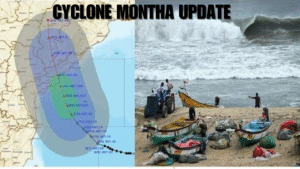What’s happening?
Cyclone Montha is a strong weather system that is circling the Bay of Bengal and preparing to hit the east coast of India. It is a “severe cyclonic storm,” according to the India Meteorological Department (IMD), with maximum sustained winds of 90 to 100 km/h and gusts of up to 110 km/h. Important districts in Andhra Pradesh, Odisha, and Telangana have received red alerts due to high winds and severe to extremely heavy rains.

Where and when is the landfall expected?
By the evening or night of October 28, 2025, Cyclone Montha is expected to reach land between Machilipatnam and Kalingapatnam, close to Kakinada (Andhra Pradesh), according to the IMD. In low-lying coastal sections of Andhra and the surrounding territories, a storm surge of roughly one meter above the astronomical tide is anticipated at that time.
Which states and districts are most at risk ?
Andhra Pradesh:
Red or orange alerts are in effect for a number of coastal districts, including Visakhapatnam, Kakinada, Konaseema, West Godavari, and East Godavari.
Odisha:
Red alerts are in effect for coastal and southern districts, including Malkangiri, Koraput, Rayagada, Ganjam, and Gajapati.
Telangana:
Red alerts have been issued for districts such as Jayashankar Bhupalpally, Mulugu, Bhadradri Kothagudem, and Mahabubabad due to heavy rains and strong winds.
What are the expected impacts?
1.Over the following few days, coastal and nearby inland areas may get heavy to very heavy rainfall (in many places, until October 30).
2.Near landfall, strong winds of 90 to 110 km/h with greater gusts might uproot trees and damage structures and power lines.
3.coastal inundation and storm surge in low-lying areas, particularly in the vicinity of landfall.
4.Transportation disruptions include planes being rerouted, trains being cancelled, and fisherman being told to avoid the sea.
5.Secondary risks include inundation of agricultural land, landslides, and flooding, particularly in Odisha’s mountainous regions.
What is the government doing?
evacuations of Andhra Pradesh and Odisha’s low-lying and vulnerable coastal districts immediately. Tens of thousands relocated to camps for assistance.
Shelter preparedness: relief centres and shelters for cyclones have been activated, particularly for elderly, pregnant, and child victims.
Statewide mobilization: Many districts have cancelled the leave of government personnel, the power and transportation departments are on notice, and disaster response teams (NDRF/SDRF) have been activated.
The Times of India, plus one Travel is discouraged till further notice; schools and universities are closed; fishermen are advised not to go out to sea.
What should the people do?
Keep yourself updated by following local authorities’ and IMD’s real-time updates.
Avoid going to low-lying or coastal locations right now.
Keep loose objects out of houses and make sure drainage and other projects are clear.
When it’s raining or windy, stay inside and stay away from windows.
Relocate to higher, safer land if you live close to the shore in a building that is fragile or outdated.
Have a flashlight, batteries, first aid supplies, medications, and critical documents in a waterproof pouch in your emergency kit. Warnings like this can intensify quickly, so heed them.
Why is this happening?
The Bay of Bengal is delivering warm, moist air feed which is helping Montha strengthen swiftly. Before making landfall, the system is predicted to continue deepening after moving north-northwest. This powerful system and the coastal terrain increase the likelihood of rainfall and storm surges beyond what is typical for the season.
Why this matters to you (and the region)
For states like Andhra, Odisha and regions in Telangana:
1.If warnings are disregarded, there is a serious risk to life and property if cyclone comes.
2.Crop damage and floods can occur on agricultural grounds, particularly in coastal and delta areas if cyclone arrives.
3.Normal life and relief operations may be impacted by disruptions to infrastructure, such as roads, electrical lines, and communication. Cyclone Is very dangerous for the human and for the economy.
How to stay safe and help others
Provide friends and family with trustworthy information, particularly in areas that are susceptible.
Volunteer if you can: a lot of community-based relief initiatives require assistance with meal preparation, transportation, and sandbagging.
Following the storm, steer clear of downed power lines, avoid areas that have flooded, and be cautious around contaminated water and slopes that are prone to landslides in
Cyclone Montha is a severe meteorological phenomenon that necessitates readiness and attention. Red alerts from the IMD should not be ignored. The lesson is clear for the states of Andhra Pradesh, Odisha, and Telangana, as well as for all of us who closely monitor these events: be prepared now, take preventative action, and stay safe before cyclone comes at the door.